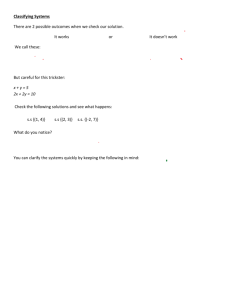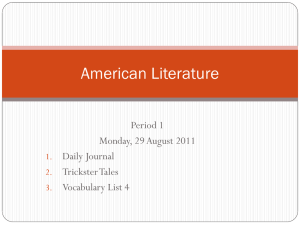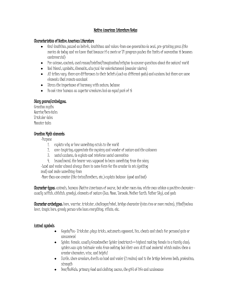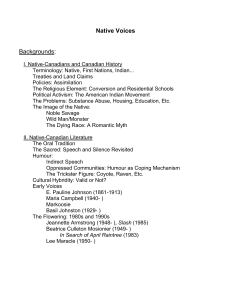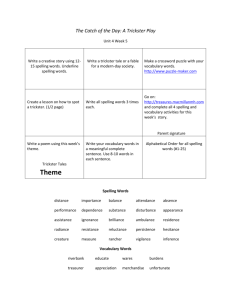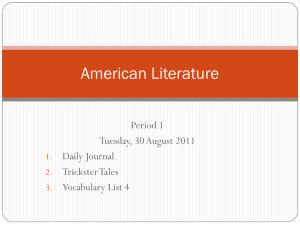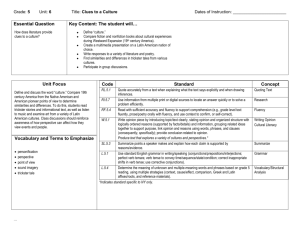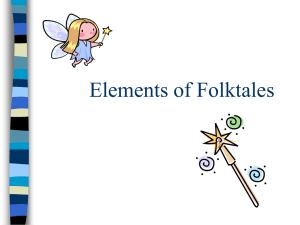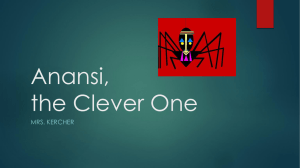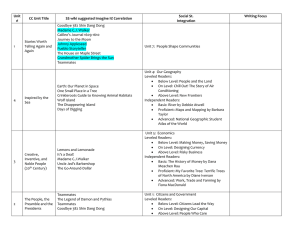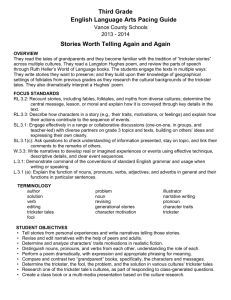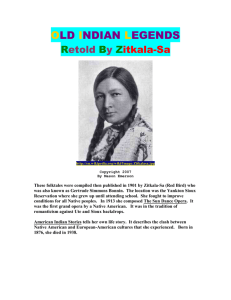UNIT 1: Northern Africa and Southwest Asia - K
advertisement
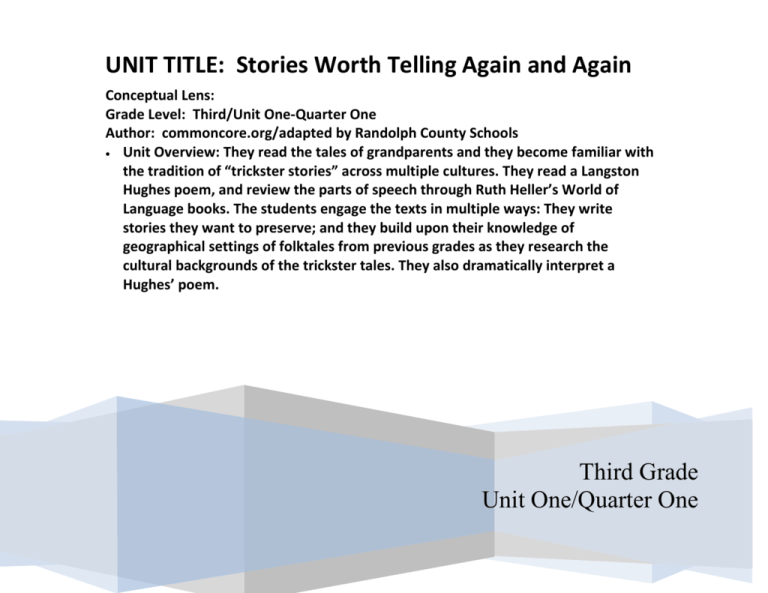
UNIT TITLE: Stories Worth Telling Again and Again Conceptual Lens: Grade Level: Third/Unit One-Quarter One Author: commoncore.org/adapted by Randolph County Schools Unit Overview: They read the tales of grandparents and they become familiar with the tradition of “trickster stories” across multiple cultures. They read a Langston Hughes poem, and review the parts of speech through Ruth Heller’s World of Language books. The students engage the texts in multiple ways: They write stories they want to preserve; and they build upon their knowledge of geographical settings of folktales from previous grades as they research the cultural backgrounds of the trickster tales. They also dramatically interpret a Hughes’ poem. Third Grade Unit One/Quarter One Essential Understandings (Generalizations) and Guiding Questions: Assessment Codes SA = Student Self-Assessment WS = Work Samples PT = Performance Tasks Q = Quizzes T = Tests P = Prompts Unit Goals Reading Works independently during literacy block (O) RL 3.2 Recount stories, determine the central message, lesson, or moral and explain how it is conveyed through key details in the text. (O, C, RR) O = Observations C = Checklists/Notes RR =Reading Record Learning Targets I can monitor my comprehension using a variety of strategies (using background knowledge/schema, coding the text, rereading, etc). Essential Questions What do good readers do? Am I clear about what I just read? How do I know? I can make text-self, text-text, and text-world connections to comprehend text. RL 3.3 Describe characters in a story and explain how their actions contribute to the sequence of events. (O, WS) R.L.3.2 I can retell stories using the characters, setting, and plot. RL 3.7 Explain how specific aspects of a text’s illustrations contribute to what is conveyed by the words in a story. (O, WS) I can define the central message, lesson and/or moral of the story. I can explain the central message, lesson and/or moral of the story using key details. R.L.3.3 I can identify characters in a story. I can describe characters in a story using physical and emotional traits. I can explain how characters actions cause events to occur in a certain order/sequence. RL3.7 I can identify illustrations that support the story. I can explain how illustrations contribute to the Page 2 of 14 In what ways does creative choice impact an audience? Who’s story is it? Why does it matter? Assess ment Codes words in the story. RL3.9 Writing/ Language Additional Literacy Generate ideas for writing and work independently during writer’s workshop (WS) Demonstrate narrow focus on a single topic. (WS) W 3.3 Write narratives to develop real or imagined experiences or events using effective technique, descriptive details, and clear event sequences. (WS) W 3.4/3.5 With support, produce writing that is developed, organized and has been edited and revised. (O, WS) I can define settings and plots. I can identify settings and plots in stories written by the same author. I can compare and contrast settings and plots. W.3.3 I can define narrative text and define the basic parts of plot. I can introduce the narrator, characters and the event/situation that starts the story. I can sequence the events in my story so that one event leads to the next. I can use a character’s thoughts, words, feelings and actions to show how events happen and how characters respond to the events. I can show changes in time by using temporal words and phrases (before, during and after). I can write a conclusion that provides a sense of closure. W.3.4 I can identify the purpose of a narrative text. I can use graphic organizers to develop my writing ideas. W.3.5 I can use pre-writing strategies to formulate ideas. I can recognize that good writing requires more than one draft. I can revise my writing with the help of others. I can edit my writing by checking for errors in capitalization, punctuation and spelling. I can prepare a new draft with changes that strengthen my writing. Students will ask questions when they do not understand. SL 3.1 I can read or study materials to be discussed. Students will recognize a complete sentence. I can list important information about the topic to be discussed. Students will speak in complete Page 3 of 14 What do good writers do? What is my purpose? How do I develop it? Writing clearly: What makes a difference? Final product: What does it take? What makes collaboration meaningful? Making meaning from a variety of sources: What will help? sentences. SL 3.1 Engage in discussions building on others’ ideas and expressing their own clearly. (O) I can identify and follow the agreed upon rules for discussion I can ask questions when I do not understand. SL 3.3 Ask and answer questions about information from a speaker. I can stay on topic by making comments about the information being discussed. L 3.4 Determine meaning of words and phrases using context clues. I can make connections between the comments of others. I can explain my own ideas and tell what I’ve learned from a discussion. SL 3.2 I can identify information from a text being read aloud. I can identify information that is presented in different formats. I can use the information gathered to determine the main idea and support details of a presentation. SL 3.3 I can ask questions about a speaker’s presentation when I do not understand or need more information. I can answer questions about a speaker’s presentation by using appropriate elaboration and detail. SL 3.6 I can recognize a complete sentence. I can speak using complete sentences when asked to provide details or clarification. L 3.1 I can define nouns, pronouns, verbs, adjective and adverbs and explain how they function in a sentence. I can identify comparative adjectives/adverbs and superlative adjectives/adverbs and choose the correct form when writing or speaking. Page 4 of 14 Why do the rules of language matter? Communicating clearly: What does it take? L 3.2 I can use a comma to separate the city and state in an address and punctuate dialogue. I can identify misspelled words and use resources to assist me in spelling correctly. I can spell high frequency words correctly. I can write words correctly using common spelling patterns and generalizations. L 3.4 I can determine the meaning of unknown words using context clues. L 3.5 I can make real life connections to words to I hear and read. L 3.6 I can read grade appropriate words/phrases including words that signal time and place relationships. Page 5 of 14 When a word doesn’t make sense, what can I do? How do I use what I know to figure out what I don’t know? Performance Tasks and Scoring Guides/Rubric Performance Task #1 including Scoring Guide/Rubric Prerequisite: Teachers will have completed a guided mini- investigation with students either through language arts or content area. Sample mini-investigations/instructions can be found here. Task: Using a picture book, students will create a mini-investigation including plot summary and one main character description (including character traits). One section will also be devoted to describing the effects of the illustrations on the story itself. Students will present the mininvestigation to their class, allowing for a question/answer period. Rubric for Literature/Speaking and Listening CRITERIA Plot Main character description Illustration Classroom presentation EXCELLENT (4 PTS.) Includes the components of a five finger retell with additional details/insights to support the story. Includes four or more character traits, focusing more on internal traits. PROFICIENT (3 PTS.) Includes the components of a five finger retell (Characters, setting, problem, events, ending) Includes three character traits (must include at least one internal trait). DEVELOPING (2 PTS.) Includes four components of a five finger retell. LIMITED (1 PT.) Includes three or less components of a five finger retell. Includes two character traits (must include one internal and one external trait). Includes one character trait (internal or external). Explains and elaborates how illustrations from the book contribute to the story. Able to present investigation to class and is able to answer and elaborate on at least two questions. Explains with details how an illustration from the book contributes to the story. Able to present investigation to class and is able to answer two questions from teacher or peers about investigation. Has a basic understanding of how an illustration from the book contributes to the story. Presents investigation to class, but is able to only answer one question from teacher or peers about investigation. Unable to explain how an illustration contributes to the story. Total Points Page 6 of 14 Presents investigation to class, but is not able to answer any questions from teacher or peers about investigation. Suggested Learning Experiences Launching Lessons Jan Richardson’s First 20 Days Daily Five Reading Units of Study - The Comprehension Toolkit – Whole Group Reading Mini-Lessons Monitoring Unit Texts Cluster 1: Monitor Comprehension 1. Follow Your Inner Conversation Listen to the voice in your head and leave tracks of your thinking 2. Notice When You Lose Your Way Monitoring your inner voice to focus your thinking 3. Read, Write and Talk Think your way through the text Cluster 2: Activate & Connect 4. Follow the Text Signposts Use nonfiction features to guide learning 5. Merge Your Thinking With New Learning Read and think about new information 6. Connect the New to the Known Activate and build background knowledge The Stories Julian Tells by Ann Cameron Wilfrid Gordon McDonald Partridge by Mem Fox Knots on a Counting Rope by Bill Martin Jr. and John Archambault Tops and Bottoms by Janet Stevens Grandfather’s Journey by Allen Say Through Grandpa’s Eyes by Patricia MacLachlan Unit Texts Bones! All Kinds of Hands, All Kinds of Feet by Rosanna Hansen Muscles by Seymour Simon Me and My Amazing Body by Joan Sweeney *All of the above can be found in the Scholastic Science Kit books that all schools received in the past. Celebrating the Day of the Dead Any Paul Goble books Any of the above Science books Any of the above Science books Page 7 of 14 District Suggested Texts Amelia’s Road by Linda Altman Fly Away Home by Eve Bunting Any difficult text Testing, Testing Sourcebook District Suggested Texts The Life and Times of the Peanut by Charles Micucci Any nonfiction book with lots of text features Mexico Toolkit Texts 2/3 Celebrating the Day of the Dead The Horse Close Up Sam Goes Trucking Exploring Our Forests Toolkit Texts 2/3 Summer of the Shark Sourcebook Additional Reading Mini-Lessons/Shared Reading and Shared Writing Activities Interactive Read Alouds; Linking Standards, Fluency, and Comprehension by Linda Hoyt Monitoring Comprehension/Schema – pg. 1 – Using Prior Knowledge Making Connections – pg. 9 – Make Connections Pg. 13 – Connect to Experiences of Others Story Elements- pg. 135 – Problem/Solution Main Idea/Details – pg. 49 – Identifying Main Ideas and Supporting Details Describing Characters – pg. 117 – Character Development Using Illustrations – pg. 71 – Use Pictures to Support Comprehension Settings – pg. 111 – Setting Plots – pg. 89 – Sequence of Events/Plot Compare/Contrast – pg. 41 – Compare/Contrast Sequencing Events (Writing) – pg. 305 – Sentence Fluency Vocabulary (Writing) - pg. 173 – Transition Words Conventions (Writing) – pg. 211 – Conventions Explaining Ideas (Speaking and Listening) – pg. 21 – Interpret Through Explanation Context Clues (Language) – pg. 145 – Context Clues Read Aloud Book(s) Stellaluna by Janell Cannon The Relatives Came by Cynthia Rylant Grandfather’s Journey by Allen Say Puss and Boots by Malcolm Arthur The Art Lesson by Tomie dePaola Mufaro’s Beautiful Daughters by John Steptoe The Ghost-Eye Tree by Bill Martin Jr. and John Archambault Owl Moon by Jane Yolen Goldilocks and the Three Bears by James Marshall Yo! Yes? By Chris Raschka What Do You Do With a Tail Like This? By Steve Jenkins and Robin Page Page 8 of 14 Class Discussion / Literature – Family Stories Introduce the unit by asking students if they have family stories they love to tell. Allow students to share favorite family stories for a few minutes. Introduce that day’s new chapter book: The Stories Julian Tells (Ann Cameron and Ann Strugnell). As students read the first chapter of the book, “The Pudding Like a Night on the Sea,” ask them to examine Julian as a character. You might post these leading questions and discuss their meaning by having your students ask you the questions as their new teacher: How would you describe Julian? What are his character traits? Why does he do what he does? Read the chapter aloud to the students as they follow along. Continue reading the subsequent chapters in the days that follow, encouraging as much independent reading as possible. Continue to focus on character traits and motivation. As students finish this book, allow them to choose to move to other character stories in this series or to continue with Julian. This provides the opportunity to compare and contrast books and /or characters by the same author. (RL.3.3, SL.3.6, SL.3.1b, SL.3.4, RL.3.9) Effects of Illustrations on a story Mo Willems’ book, Don’t Let the Pigeon Drive the Bus, is a great resource for letting students quickly see the impact of illustrations on the meaning of a story often with few words. Literary Response After reading Knots on a Counting Rope (John Archambault, Ted Rand, and Bill Martin, Jr.), review the character traits of the boy and his grandfather. Have the students partner up and list three characteristics for each. Introduce another story that honors grandparents: Through Grandpa’s Eyes (Patricia Maclachlan and Deborah Kogan Ray). As students finish reading the new book, have them work with the same partner to list at least three characteristics of each character in the new story. How are the grandparents similar and different? How are the grandchildren similar and different? What is the message of each book? What do you think the author might have wanted you to learn? (RL.3.3) Literary Response – Trickster Tales Lead a discussion with the students to introduce the genre of trickster tales, using questions such as these: One of the types of folk stories handed down in cultures is a “trickster tale.” What root word do you hear in “trickster”? Have you ever played a trick on someone? Have you ever had a trick played on you? Tell students that “trickster tales” are stories that involve playing tricks to solve problems, and to make them even more interesting, that they are from different cultures. As students read, encourage them to think about characters and their traits. Remind them that the story is not just in the text but also in the illustrations. The illustrations help to tell the story and to give hints about the culture or origin. Use the following questions to guide discussions after they (or you) read the Page 9 of 14 trickster stories. Eventually require students to answer these questions independently. Who is the trickster? Who is the fool who gets tricked? What was the problem in the story? How did the trick solve the problem? Think about what the message of the story might be and why these stories have been told for hundreds of years. (RL.3.2, RL.3.3, RL.3.7) Shared Research Students have read a variety of trickster tales from various cultures. Now it is time to center on one of the cultures. You could, for example, choose to focus on the Plains Native American culture after reading the “Iktomi” tales by Paul Goble by assigning a short class research project on it. In small groups, have students brainstorm questions that can be answered about the culture. Assign each small group a question to answer. Use the internet, encyclopedias, and informational books to answer questions. When the students have finished their projects, create a class book or multimedia presentation to show what they have learned about the culture. When you are finished, ask “Why did the Plains Indians create trickster stories to tell to their children?” This activity can be repeated with any of the cultures from which trickster stories came.(W.3.6, W.3.7, W.3.8) Poetry Performance Give the students this prompt: “Choose one of the Langston Hughes poems to memorize or read interpretively. Be sure to communicate the meaning of the poem in the way you recite or read it. ”Demonstrate fluent reading to the children, being sure to show how meaningful phrasing and expression guide the dramatic interpretation of a poem. (RF.3.4b) Class Discussion / Art Appreciation Paul Goble is a talented artist who though not a Native American, has been fascinated by Native American life for many years and has dedicated his much of his art to the culture. Read the following quote to the students: “[Goble’s] art is tremendous because he is able to recreate the traditional forms with great accuracy and detail. The designs he draws are completely authentic and his colors are the same ones that were used by the old-timers before the reservation days. He is able to recreate the spirit of the old stories with his illustrations and his words.” —Joe Medicine Crow, Crow Tribal Historian, and oldest living member of the Crow Tribe Discuss the following questions with the students: What does this quote mean? How do you think this quote by a Native American made Paul Goble feel when he heard it for the first time? (SL.3.1c,RL.3.7) Page 10 of 14 Writer’s Workshop Calkins Launching Unit Set up writer’s workshop routines and procedures. Small Moments Unit Narrative Writing Students have been sharing favorite family stories so shift the discussion to how stories are passed down from grandparents specifically. Then, assign the following: “Interview one of your family members (e.g., a parent, grandparent, or aunt) to learn a family story. Save the story by taking notes or by recording it digitally. Use the story you record to write a narrative. ”This writing project should be worked on over an extended period of time, revising and editing using the standards as guidance. (W.3.3, W.3.4, W.3.5, L.3.1, L.3.2, L.3.3) Class Discussion / Language Ruth Heller has written a series of informational books that teach parts of speech. Remind students they learned about “nouns” in second grade. As you read the book Merry-Go-Round: A Book About Nouns (Ruth Heller), have the students listen for more information about nouns. Pause as you read to allow the students to share what they are learning or to ask questions. Review nouns, pronouns, and verbs using the Ruth Heller series. Create word banks for each part of speech and add vocabulary from class work to reinforce the application. (RI.3.1, L.3.1a, L.3.1b, L.3.1c, L.3.1d, L.3.1e, L.3.1f) Word Study/Vocabulary Lessons Begin vocabulary notebook. Phonics Lessons from Fountas and Pinnell L. 3.2(f) Use spelling patterns and generalizations in writing words (e.g., word families, position-based spellings, syllable patterns, ending rules, meaningful word parts) o o o o o o o o HF 1 Recognizing High Frequency Words (with 3 or More Letters) (pg. 223) SP 3 Recognizing Word Patterns with Long Vowel Sounds (pg. 161) SP 4 Recognizing Phonograms with Double Vowels (pg. 165) SP 9 Recognizing Word Patterns with Vowel Combinations (pg. 185) LS 8 Recognizing Long Vowel Patterns ai, ay, ee, oa, ow, ue, ui, ew (pg. 103) **May be used for multiple sessions LS 6 Identifying Words with Different Vowel Sounds oo, ow, ea (pg. 95) LS 7 Recognizing Other Vowel Sounds oo, oi, oy, ow, aw, au (pg. 99) SP 6 Recognizing Word Patterns with Unique Vowel Sounds (pg. 173) Page 11 of 14 Unit Materials/Resources Suggested Works o (E) indicates a CCSS exemplar text; (EA) indicates a text from a writer with other works identified as exemplars. Literary Texts Stories Our stories: The Stories Julian Tells (Ann Cameron and Ann Strugnell) (E) More Stories Julian Tells (Ann Cameron and Ann Strugnell) (EA) The Stories Huey Tells (Ann Cameron and Roberta Smith) (EA) Gloria’s Way (Ann Cameron and Lis Toft) (EA) Grandparents’ stories: Grandfather’s Journey(SMART activities) (Allen Say) (EA) Tea with Milk (Allen Say) (EA) Song and Dance Man (Karen Ackerman and Stephen Gammel) Snowed in with Grandmother Silk (Carol Fenner and Amanda Harvey) Annie and the Old One (Miska Miles and Peter Parnall) Through Grandpa’s Eyes (Patricia Maclachlan and Deborah Kogan Ray) (EA) Knots on a Counting Rope (John Archambault, Ted Rand, and Bill Martin, Jr.) The Memory String (GREAT character trait graphic) (Eve Bunting and Ted Rand) Cultural trickster stories: Tops & Bottoms (Janet Stevens) (E) Bruh Rabbit and the Tar Baby Girl (Virginia Hamilton and James Randome) Love and Roast Chicken: A Trickster Tale from the Andes Iktomi and the Boulder (Paul Goble) Iktomi and the Berries (Paul Goble) Iktomi Loses His Eyes (Paul Goble) Poems “Grandpa’s Stories” (Langston Hughes) (E) Video that can be used with this poem (with support) “Aunt Sue’s Stories” (Langston Hughes) (EA) *Link also has questions to go along with poem. “Mother to Son” (Langston Hughes) (EA) “By Myself” (Eloise Greenfield) This link includes activities for “By Myself” Stories (Read Aloud) The Apple and the Arrow (Mary Buff) Sign of the Beaver (Elizabeth Geroge Speare) Poems (Read Aloud) “Your World” (Georgia Douglas Johnson) (E) “The Telephone” (Robert Frost) (EA) YouTube video of two people acting out poem “Nani” (Alberto Rios) “You Are Old, Father William” (Lewis Carroll) (EA) “For want of a nail, the shoe was lost…” (Traditional) Informational Texts Students will do internet research on a culture related to a favorite trickster tale: African American slave culture European culture (choose specific country) Page 12 of 14 Mountains (Barbara Knutson) Iktomi and the Buzzard (Paul Goble) Iktomi and the Coyote (Paul Goble) Mine, All Mine: A Book About Pronouns (World of Language) (Ruth Heller) A Cache of Jewels and Other Collective Nouns (World of Language) (Ruth Heller) Kites Sail High: A Book About Verbs (World of Language) (Ruth Heller) Art, Music, and Media Art Paul Goble, works (1933-present) Native American (Plains) culture Andes Mountain culture Informational Text (Read Aloud) Throw Your Tooth on the Roof: Tooth Traditions Around the World (Selby Beeler and G. Brian Karas) (E) Merry-Go-Round: A Book About Nouns (World of Language) (Ruth Heller) Additional Resources • Dylan Pritchett: Storyteller (cuesheet) (The Kennedy Center) (SL.3.4, W.3.3) Note: This is a presentation on storytelling for children. • Fables and Trickster Tales Around the World (National Endowment for the Humanities) (RL.3.2) • Dynamite Diamante Poetry (ReadWriteThink)(L.3.1a) Note: This is an activity on nouns. • Composing Cinquain Poems with Basic Parts of Speech (ReadWriteThink) (L.3.1a) • Using Picture Books to Teach Characterization in Writing Workshop (ReadWriteThink) (RL.3.3) • Maps of United States Indians by State (Native Languages of the Americas) (RI.3.7) • Native American Informational Chart (Mountain City Elementary School, Mountain City, TN) (RI.3.5) • A Collection of Trickster Tales (American Folklore.Net) (RL.3.2) Teacher Notes Vocabulary Teacher Notes: This unit is a natural fit for inviting grandparents into the classroom to tell their own stories or to read the stories under the “grandparent story” section. At the beginning of the school year, you may see some unique opportunities to engage the grandparents with their own grandchildren’s learning or to volunteer in the classroom. A Grandparents’ Day would be a perfect celebration to include in this unit. author illustrator noun verb collective noun pronoun verb tenses generational stories Page 13 of 14 problem solution internet search shared research narrative writing revising editing character traits trickster tales the trickster the fool Hyperlinks for additional resources Fables PowerPoint – Shows the difference between fables and folktales Folktales, Fables, Fairy tales, includes posters Peer Edit With Perfection: Effective Strategies - ReadWriteThink 3rd Grade Unit 1 overview from Jordan Schools. Has a lot of great ideas, but some may not match with our pacing. Third grade Common Core reading/literature links Character Traits Character using the book The Memory String Third Grade Unit 1 Wiki with a lot of great links character motivation Making Interdisciplinary Connections This unit teaches: Art: Artist as historian (e.g., Paul Goble) Geography: Cultures (e.g., Plains Indians and Andes Mountain tribes) This unit could be extended to teach: Music: Music of featured cultures (e.g. spirituals and Quechua songs) Geography: U.S. geography (as related to Native Americans) History: Native American Nations (e.g., the Bering land bridge theory, Southwest, Eastern “Woodland”) Page 14 of 14
